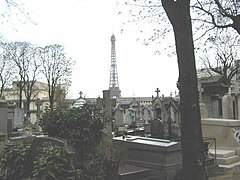Cimetière de Passy

The Cimetière de Passy, with the Eiffel Tower in the background
|
|
| Passy in Paris | |
| Details | |
|---|---|
| Established | 1820 |
| Location | Passy, Paris |
| Country | France |
| Coordinates | 48°51′45″N 2°17′07″E / 48.86250°N 2.28528°ECoordinates: 48°51′45″N 2°17′07″E / 48.86250°N 2.28528°E |
| Type | Public |
| Owned by | Mairie de Paris |
| Size | 1.75 hectares (4.3 acres) |
| No. of graves | 2600 |
| Website | Passy cemetery on the Mairie de Paris |
| Find a Grave | Passy Cemetery |
Passy Cemetery (French: Cimetière de Passy) is a cemetery in Passy, in the 16th arrondissement of Paris, France.
The current cemetery replaced the old cemetery (l'ancien cimetière communal de Passy##, located on Rue Lekain), which was closed in 1802.
In the early 19th century, on the orders of Napoleon I, Emperor of the French, all the cemeteries in Paris were replaced by several large new ones outside the precincts of the capital. Montmartre Cemetery was built in the north, Père Lachaise Cemetery in the east, and Montparnasse Cemetery in the south. Passy Cemetery was a later addition, but has its origins in the same edict.
The current entrance was built in 1934 (designed by René Berger). The retaining wall of the cemetery is adorned with a bas relief (by Louis Janthial) commemorating the soldiers who fell in World War I.
Opened in 1820 in the expensive residential and commercial districts of the Right Bank near the Champs-Élysées, by 1874 the small Passy Cemetery had become the aristocratic necropolis of Paris. It is the only cemetery in Paris to have a heated waiting-room.
Sheltered by a bower of chestnut trees, the cemetery is in the shadow of the Eiffel Tower.
The cemetery was once the home of a statue by Dunikowski titled The Soul Escaping the Body. It was on top of the ceremonial grave of Antoni Cierplikowski. The statue was known by many but was removed when the grave was cleared in 2004.
It is known as a small but well visited cemetery (Petit mais bien fréquenté).
...
Wikipedia

